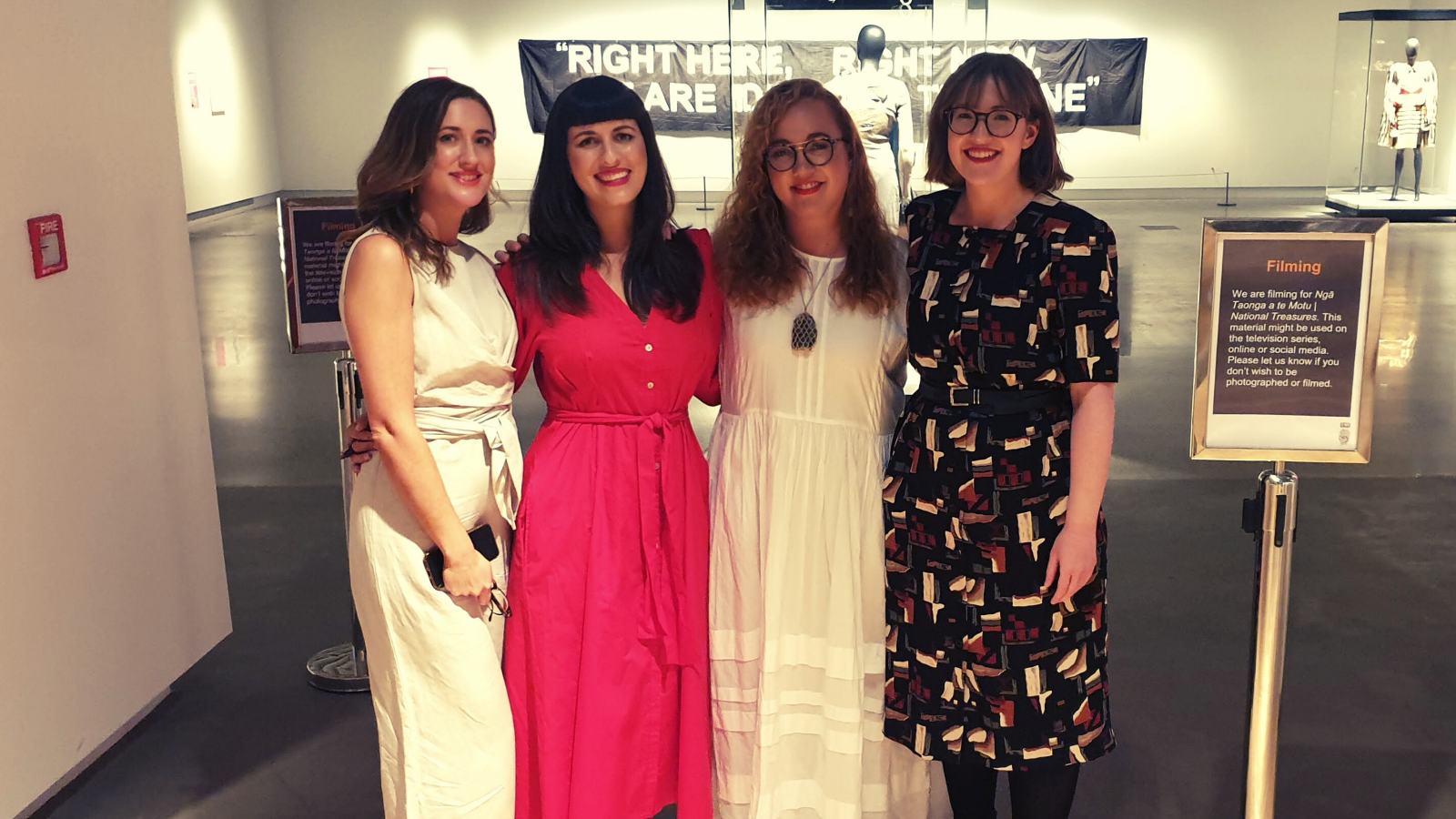
Jane and Nina work at Auckland Museum, with Jane working as senior collection manager, human history, while Nina is curator manuscripts; and Matariki (Tūhoe, Te Ātiawa, Ngāti Whakaue, Ngāti Hauiti) is curator mātauranga Māori at Te Papa Tongarewa. Te reo Māori experts Scotty and Stacy Morrison host the programme, and Oscar Kightley, fellow Te Papa curator Katie Cooper, and another alumnus, historian Dr Jock Phillips also present.
The show features stories based either in a museum setting or at people’s homes, with the “on the road” segments led by Scotty. Taonga the women worked with included a flag used in the Bastion Point protest; clothing and a body tag from the Chistchurch earthquake; and a diary and song about the Tangiwai railway disaster, among others.
It was the first time any of the three women had been on TV. “It was really exciting. Once we were together on the day of the filming, that settled our nerves quickly. We’re not just colleagues, we’re also really good friends—us three and the others. It was a comforting and lovely experience to do it together, and it made me feel quite safe,” says Nina.
They were each assigned people, stories, and taonga in advance, and given a chance to research them further before speaking to the objects’ caretakers.
“We were titled as ‘experts’, but those bringing their objects in were the true experts of their stories. We asked quite open questions, so that they could tell their own story. We were the contextualisers, putting the history into context afterwards,” says Matariki.
“This is akin to what we do in our ordinary jobs, interviewing donors about potential acquisitions,” says Nina. “Once we knew what was expected of us, we felt quite comfortable leading a free-flowing conversation with people on the show,” adds Jane.
The three women came to study Museum and Heritage Studies from different areas of interest. Matariki’s background was a Bachelor’s degree in history and Māori studies, and she worked for Huia Publishing before changing careers. “I got the bug working for a museum when I worked briefly in Te Papa’s image library before travelling, and on my return I had a small baby and chose to come and do museum studies in Wellington. I had good study / life balance, and was into the idea of the practicuums you have in museum studies.”
Jane and Nina were both looking for something more vocational than their art history degrees. Jane says, “I was more interested in objects and decorative arts, so I carried on to do a post-graduate diploma in museum and heritage studies to give myself a more practical avenue for what I was interested in.”
One of the aims of the show is to make people feel like they are part of history, and many of the taonga selected for the show from an open call are related to modern history. “The show opens with Oscar looking at a wooden plank from a classroom floor, which a teacher used to hide pasifika students during the Dawn Raids. It’s a gut punch. This part of history is being talked about to this day, the Polynesian Panthers are seeking an apology from the Crown for what was done during that era to Pacific communities,” says Matariki.
“We need to talk about these histories, as hard as they may be. And having that told at a personal level is really important,” she adds.
Each has their own most affecting moment from the show, with Nina’s being hearing John Archer’s experience of the Tangiwai railway disaster, New Zealand’s worst railway accident when 151 people died. She explains, “When you’re speaking to somebody who was a child at this event in 1953, you realise just how close history is. That veil of objectivity falls away, and you realise it never existed.”
Jane is from Christchurch, and the clothes and body tag that Monique McLellan brought in to explain her experience in the CTV building during the Christchurch earthquakes struck a chord for her. “It was such an emotional story. It stayed with me because it’s so close to home, so immediate.”
Matariki was blown away by the flag that Sharon Hawke brought in from Takaparawhā, the Bastion Point occupation. “The occupation is talked about as the starting point, but it’s actually just the start of a new chapter. Ngāti Whātua is now thriving, but also still fighting.”
Nina says, “We all know this, but you realise history truly is made up of people, and their stories. It’s very obvious and beautiful and sad all at once.”
Matariki adds, “Events like this, like the Christchurch earthquake, Bastion point, the way they are talked about is as almost monolithic touchpoints in our history, but when you go into them all, they are people that are affected.”
All three women agreed being part of this production about New Zealand’s history was incredibly special. They hope to see a second season funded.
